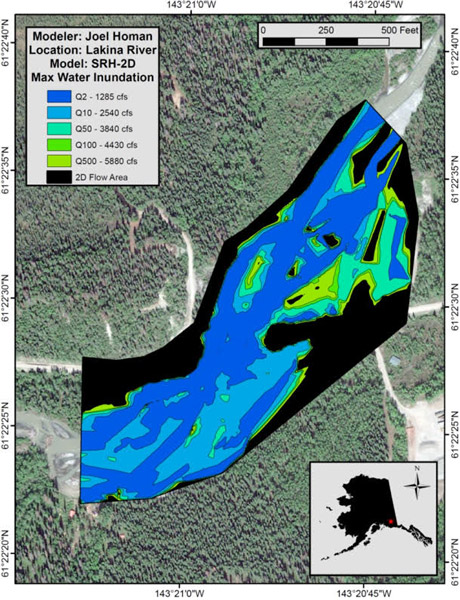
Image above: 2D hydraulic modeling results of a section of the Lakina River, Alaska..
Photo Credit: Joel Homan.
Hydraulic engineers working on consulting companies and/or state agencies have a series of tools at their disposal to perform design work. Some of these tools involve equations that can be solved explicitly (for instance, Manning’s equation), or numerically (for example, the backwater equation), plus a series of numerical models with different levels of complexity (for instance: hydrodynamic or hydro-sedimentological; 1, 2, or 3 dimensional models). While the value of using numerical models should be obvious in general, there are some important issues that should be addressed, such as comparison of results acquired using different models, and, to some extent, assessment of model results generated by different users. Furthermore, hydraulic engineers may use various free or commercially available modeling software programs. This lack of standardization, or consistency in treatment of data, certainly adds an additional layer of complexity to the evaluation process for bridge design. At the federal level, the Federal Highway Administration (FHWA) is promoting the use of two-dimensional (2D) models for bridge hydraulic simulations. The hydraulics group in the Alaska Department of Transportation (AKDOT) intends to follow the FHWA’s directions and develop expertise in two particular hydraulic models: the Sedimentation and River Hydraulic two-dimensional (SRH-2D) model developed by the Bureau of Reclamation (USBR, 2017). However, the group recognizes that consultants and/or other agencies may use, and consequently submit, results obtained from different numerical models. The AKDOT hydraulic engineers have identified a need for guidelines for 2D model review and acceptance.
Please note that this week's seminar takes places at the Pub on campus, not in Duckering 531!
Join this seminar from your computer, tablet or smartphone.
Or use audio via phone:
United States (Toll Free): 1 877 309 2073
Access Code: 782-427-733